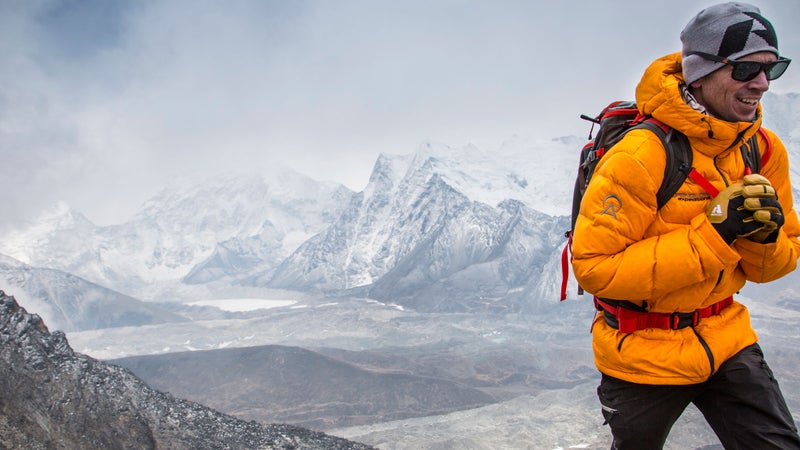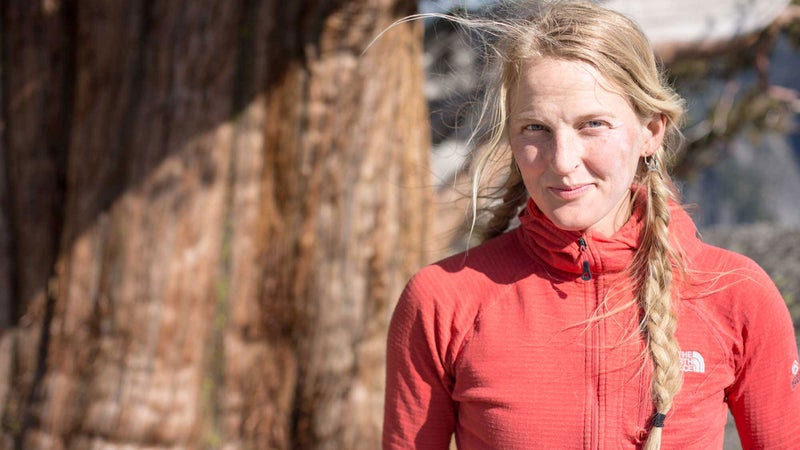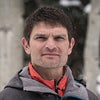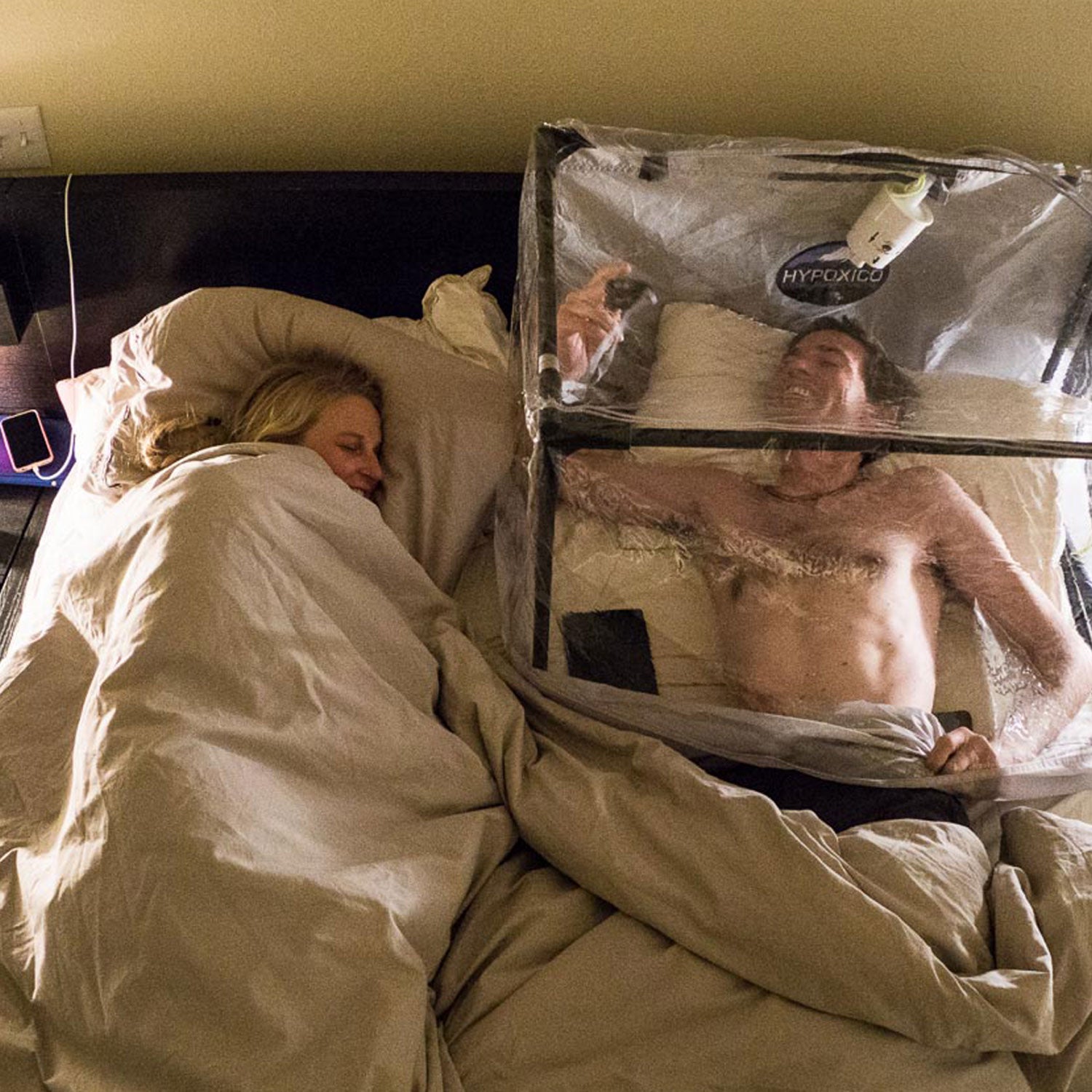If all goes as planned, Lake Tahoe mountaineers Adrian Ballinger and Emily Harrington will be standing on the summit of 26,906-foot in Asia less than a month from now. But when asked in early September what their departure date was, instead of rattling off the day and hour—which normally would inspire a month-long countdown in most climbers’ households—Harrington laughed.
“We don’t have one,” she said. “We’re just going to wait for a weather window.”
Their last-minute deployment is part of a first-of-its-kind expedition the couple is undertaking this fall that they're calling Cho Oyu Speed.��Their goal: Climb the world’s sixth tallest mountain in two weeks or less, travel time included.��
“We’ve been asking our friends, other guides, and Sherpa, and a month is pretty much the quickest anyone’s heard of someone climbing an 8,000-meter peak in the past,” says Ballinger, who climbed and skied Cho Oyu in 31 days in 2013. (The mountain is located at the intersection of Tibet and Nepal.)

Ballinger’s company, , already runs a “rapid ascent” commercial expedition on Cho Oyu designed for clients to summit and return home in a month—still markedly faster than the typical two- to three-month commercial timeline for climbing an 8,000-meter peak. Clients on those trips (there are two on Cho Oyu with Alpenglow this fall) are selected based on fitness and experience, and they are required to pre-acclimatize by sleeping in hypoxic tents before the expedition.��
Ballinger and Harrington also have been sleeping in hypoxic tents, as well as riding stationary bikes in hypoxic masks that allow them to push their bodies in conditions equivalent to 21,000 feet elevation. But unlike Alpenglow’s clients and guides, who were already en route to China in early September, Ballinger and Harrington were sitting at home poring over weather reports and monitoring storms in the Bay of Bengal to determine when they might depart. “We need to thread this needle, and we need to predict it probably ten days in advance, in order to buy tickets and fly,” Ballinger said.��
Here’s the plan: once Alpenglow’s guides have established base camp on the Tibetan side of the mountain, Ballinger will speak with them twice daily about route conditions while monitoring the weather from California. He and Harrington need the route to be fixed with ropes (which Alpenglow’s guides will help with) and a solid weather window before they depart the U.S.��
Once on the ground, the duo plans to move faster than normal and condense the traditional five-day trek across the Tibetan plateau from Lhasa to base camp into a single day. Then, instead of hanging out there for a day or two while their government-appointed liaison officer evaluates their permit, they hope to start moving up the mountain immediately upon arrival. Ballinger said he has been working with the Chinese Tibetan Mountaineering Association (CTMA) for months to get special permission for the hastened timeline. Even with permission, he remains cautiously optimistic.
“This is something the Chinese have never allowed in Tibet. They’re very regimented about how people climb mountains and how the permits are given and how the government liaison officers sort of set our schedules,” Ballinger said. “At this point we’ve gotten people within the CTMA and in the government in Beijing to say yes to our idea, but what happens on the ground is a total unknown.”

Harrington, 30, an elite rock climber who has made a recent foray into mountaineering, is more nervous about how her body will react to having less recovery time between big physical outputs. She has only climbed one 8,000-meter peak—Everest, in 2012, on a traditional two-month schedule—and skied from a top elevation of 22,500 feet on Makalu last year. “So a 12,000-foot ski descent after summiting an 8,000-meter peak, in a week, sounds like a big ask,” she said.
Ballinger, 40, a six-time Everest summiter, has skied two 8,000-meter peaks (Manaslu in 2011 and Cho Oyu in 2013) in five attempts. The hypoxic tents enable someone to acclimatize to 20,000 feet, but this will be his first time eliminating the standard “rotations,” or acclimatization trips up the mountain before a summit attempt. He compares the tactic to the “smash and grab” approach climbers have been using to tackle big routes in Patagonia and Alaska without having to sit around waiting for weather windows.��
“What my experience tells me, and knowing how these mountains work and how our bodies work, I believe we can remove those acclimatization trips and push quickly up and back down before major [altitude-related] symptoms set in,” Ballinger said. “And while we’re going to go as high as we possibly can without oxygen, we’ll have oxygen stashed on the upper mountain by our Sherpa team, and we are willing to use it to make this timeline.”
Cho Oyu is considered the easiest of the world’s 14 “eight-thousanders,” and the ski descent is straightforward, Ballinger says. It starts with a flat plateau near the summit and continues down a 7,000-foot bowl with pitches of about 35 to 40 degrees. To train, Ballinger and Harrington have been running and hiking an average of 3,000 to 6,000 vertical feet per day around Lake Tahoe, as well as riding their stationary bike with hypoxic masks four days a week, 90 minutes at a time. Ballinger, whose weight (143 pounds on a 6-foot-2 frame) still hasn’t rebounded from an unsuccessful oxygen-free Everest attempt last spring, also has been eating large amounts of red meat to build muscle before the attempt.��
As for gear, the couple will be testing a new ski-mountaineering kit from Petzl (including crampons, harness, and ax), and each will use skis that are 95 millimeters underfoot and mounted with tech bindings, as well as four-buckle boots with 40-below neoprene covers for warmth, and battery-powered heated socks.��
If they succeed, they could revolutionize the notion of how quickly an 8,000-meter peak can be climbed—at a premium price in the neighborhood of $75,000. Ballinger hopes to offer highly qualified commercial clients the two-week itinerary not just on Cho Oyu but also on Everest. (Although it could be more like three weeks for Everest.) For now, they are waiting at home in California, bags packed, ready to test a new way to climb the world’s biggest mountains.


